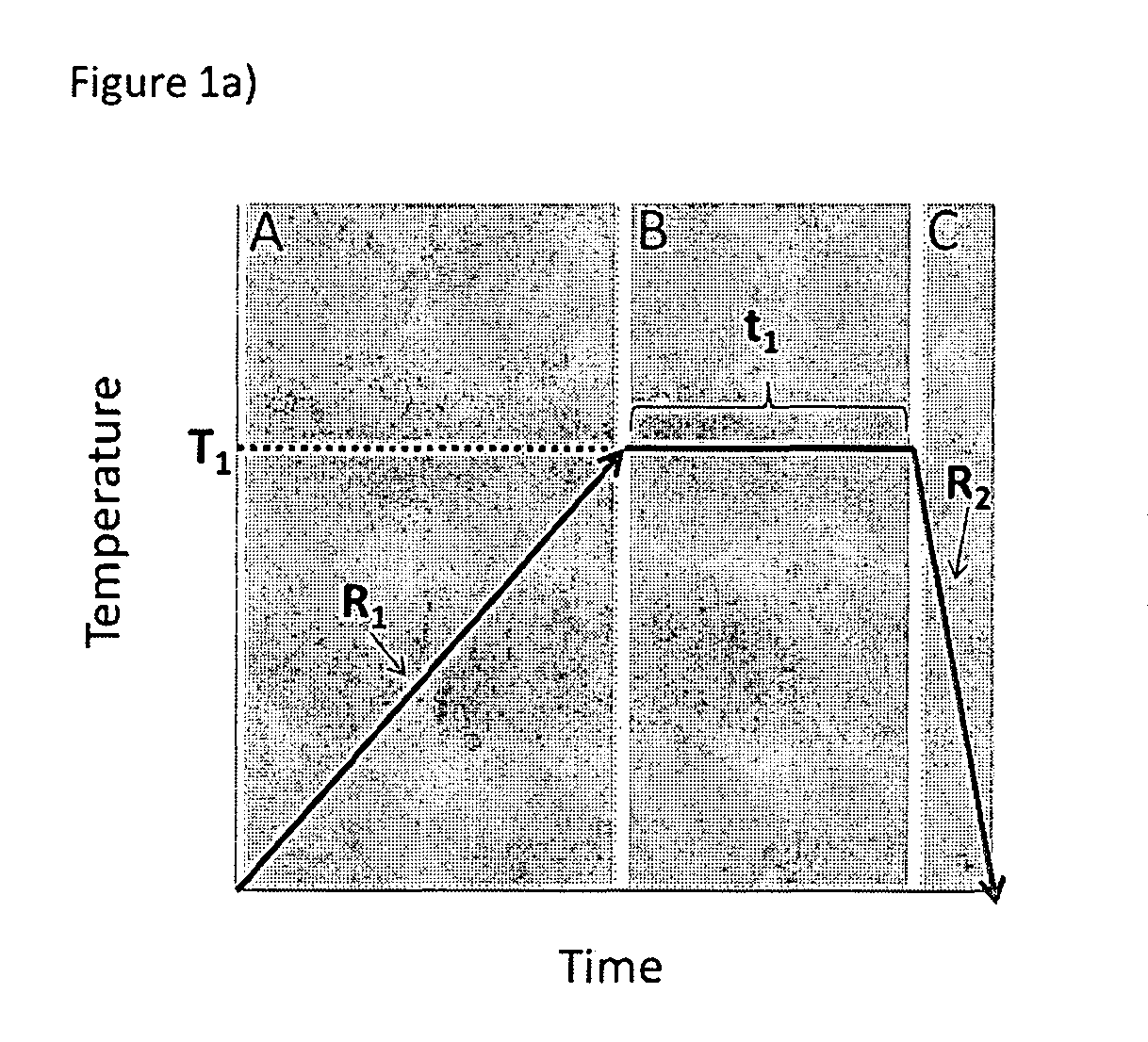Amorphous low-calcium content silicate hydraulic binders and methods for their manufacturing
a technology of low-calcium content silicate and hydraulic binders, which is applied in the direction of cement production, cement content reduction, etc., can solve the problems of little hydraulic activity, unsatisfactory by-products, and reduce the permeability of the resulting paste,
- Summary
- Abstract
- Description
- Claims
- Application Information
AI Technical Summary
Benefits of technology
Problems solved by technology
Method used
Image
Examples
example 1
Production of a Hydraulic Binder Consisting Essentially of an Amorphous Calcium Silicate with an Overall C / S Molar Ratio Equal to 1.1
[0070]A hydraulic binder with C / S molar ratio of 1.1 was obtained in a three-steps procedure comprising:[0071]A. Heating the raw mixture described in table 1 to a temperature T1 of 1500° C., at a heating rate of 25° C. / min, in the liquid region of CaO—SiO2 diagram for this composition;[0072]B. Maintaining T1 for a t1 of 60 minutes;[0073]C. Cooling to room temperature in air, at a cooling rate around 300° C. / min.
[0074]The obtained hydraulic binder, consisting in over 95% of an amorphous calcium silicate and some residual pseudowollastonite (as determined by Rietveld analysis and shown in FIG. 1c), was then ground to fineness below 30 μm and mixed with water to a water / binder ratio of 0.375 in weight.
[0075]The paste was poured in into proper molds to produce test pieces of dimensions 20×20×40 mm.
[0076]The compressive strength of this hydraulic binder aft...
example 2
Production of a Hydraulic Binder Consisting of a Fully Amorphous Calcium Silicate with an Overall C / S Molar Ratio Equal to 1.25
[0078]The hydraulic binder with an overall C / S molar ratio of 1.25 was obtained in a three-step procedure comprising:[0079]A. Heating the raw mixture described in table 2 to a temperature T1 of 1500° C., at a heating rate of 25° C. / min, in the liquid region of CaO—SiO2 diagram for this composition;[0080]B. Maintaining T1 for a t1 of approximately 60 minutes;[0081]C. Cooling to room temperature in air, at a cooling rate of about 300° C. / min.
[0082]The obtained hydraulic binder, consisting in a fully amorphous calcium silicate (as determined by Rietveld analysis and shown in FIG. 1d) was then ground to fineness below 30 μm and mixed with water to a water / binder ratio of 0.375 in weight.
[0083]The paste was poured in into proper molds to produce test pieces of dimensions 20×20×40 mm.
[0084]The compressive strength of this hydraulic binder after 28 days is higher t...
example 3
Production of a Hydraulic Binder by Mixing Alite Rich Clinker with an Amorphous Calcium Silicate, with an Overall C / S Molar Ratio Equal to 1.1, as Described in Example 1
[0087]A highly amorphous calcium silicate with an overall C / S molar ratio of 1.1 was obtained in a three-step procedure, as described in Example 1.
[0088]The obtained hydraulic binder with an overall C / S molar ratio of 1.1 was then ground to fineness below 30 μm and mixed with 10% in weight of alitic clinker.
[0089]This mixture was used to produce a paste with a water / binder ratio of 0.375 in weight.
[0090]The paste was poured in into proper molds to produce test pieces of dimensions 20×20×40 mm.
[0091]After 28 days, the compressive strength of the described blend was higher than 35 MPa due to the addition of 10% of alitic clinker.
PUM
| Property | Measurement | Unit |
|---|---|---|
| Fraction | aaaaa | aaaaa |
| Specific surface area | aaaaa | aaaaa |
| Specific surface area | aaaaa | aaaaa |
Abstract
Description
Claims
Application Information
 Login to View More
Login to View More - R&D
- Intellectual Property
- Life Sciences
- Materials
- Tech Scout
- Unparalleled Data Quality
- Higher Quality Content
- 60% Fewer Hallucinations
Browse by: Latest US Patents, China's latest patents, Technical Efficacy Thesaurus, Application Domain, Technology Topic, Popular Technical Reports.
© 2025 PatSnap. All rights reserved.Legal|Privacy policy|Modern Slavery Act Transparency Statement|Sitemap|About US| Contact US: help@patsnap.com



